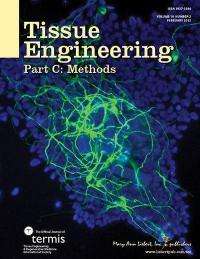3-D biomimetic scaffolds support regeneration of complex tissues from stem cells

Stem cells can be grown on biocompatible scaffolds to form complex tissues such as bone, cartilage, and muscle for repair and regeneration of damaged or diseased tissue. However, to function properly, the cells must often grow in a specific pattern or alignment. An innovative method for creating a stretched polymer scaffold that can support complex tissue architectures is described in an article in Tissue Engineering, Part C, Methods.
Zu-yong Wang and a team of researchers from National University of Singapore, Nanyang Technological University, KK Women's and Children's Hospital, and Duke-NUS Graduate Medical School, in Singapore, developed a reproducible method that involves stretching a polymer thin film to produce scaffolds that can support the growth of human mesenchymal stem cells. The stretching process creates orientated 3-dimensional micro-grooves on the surface of the films, and these formations promote consistent alignment and elongation of stem cells as they grow and develop into tissues on and around the resorbable scaffold.
The authors present their work in the article, "Biomimetic 3D anisotropic geometries by uniaxial stretch of poly(ɛ-caprolactone) films for mesenchymal stem cell proliferation, alignment and myogenic differentiation."
"The researchers developed a very elegant method to promote cell behavior," says John Jansen, DDS, PhD, Methods Co-Editor-in-Chief and Professor and Chairman, Department of Biomaterials, Radboud University Nijmegen Medical Center, The Netherlands.

















